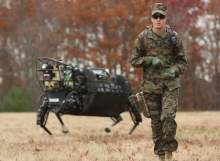
Queen Elizabeth Carrier floated out
It is sometime hard to grasp the sheer enormity of the Royal Navy’s Queen Elizabeth-class aircraft carrier programme. To give some idea of its scale, BAE Systems has released a series of timelapse progress reports.
The latest shows the first ship in class, recently named HMS Queen Elizabeth by her majesty herself, being floated out of dry dock in Rosyth. The dock was flooded over the course of several days, before the 65,000-tonne vessel was carefully manoeuvred out over three hours with just a couple of metres’ clearance on each side.
The carrier will remain in Rosyth where teams will continue to fit out the ship in preparation for handover to the Ministry of Defence for sea trials in 2016. On her journey downriver to the open sea, her mast will need to be lowered to a horizontal position on deck so she can fit under the Forth Road Bridge. HMS Queen Elizabeth really is naval technology on a royal scale.
US Marines LS3 robot
You may remember the demonstrations of the intimidating Big Dog robot by Boston Dynamics, now owned by Google. Big Dog has evolved and been released into the wild for a US Marines Marines field test at the Kahuku Training Area in Hawaii.
This latest pack-carrying robot is officially dubbed the Legged Squad Support System, or LS3, but the Marines have nick-named it Cujo after Stephen King’s horror novel about a rabid dog – not surprising when you see the way it ducks and hides in the undergrowth.
DARPA EXACTO guided bullet
However good a shot a sniper is, external factors like dust and wind can stop a bullet hitting its target, but now missed shots could become a thing of the past thanks to DARPA’s new Extreme Accuracy Tasked Ordnance, or EXACTO, system.
DARPA has recently demonstrated this first ever .50-calibre guided bullet in live-fire tests. The path of the projectile can be seen diverting away from where it is aimed towards a target identified with optical sighting technology.
The real-time guidance system includes gyroscopes, accelerometers and an atomic clock, but as there are no fins on the bullet, the way it changes direction mid-flight remains DARPA’s secret.
As every shot a sniper fires but misses give away his position, this could be an important way of ruling out human error.
Follow Berenice Baker on Google+


.gif)

